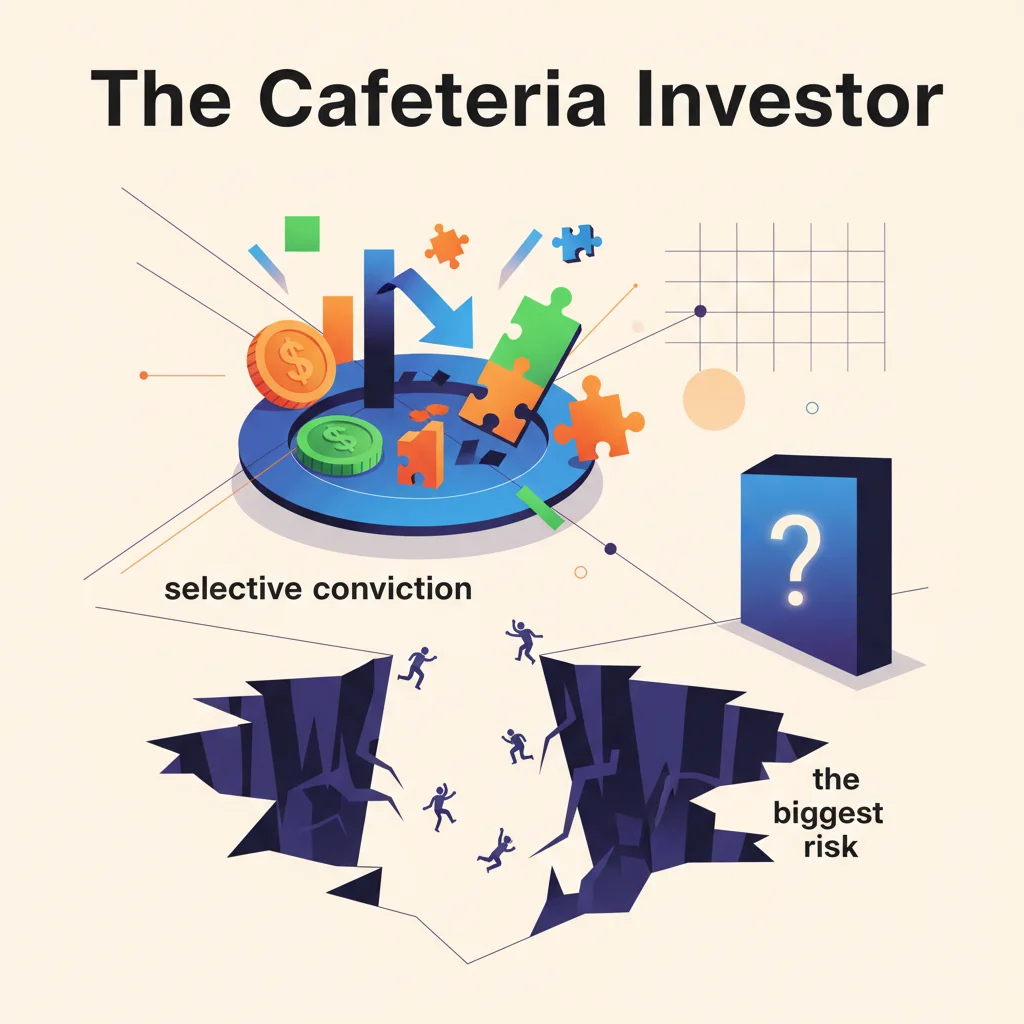
The Cafeteria Investor: Why Selective Conviction is the Biggest Risk in Modern Finance
The Peril of the Pick-and-Choose Mindset
In the world of high-stakes decision-making, consistency is a virtue. Whether in politics, ethics, or corporate governance, a principled stand is often seen as a hallmark of integrity and sound judgment. A recent letter to the Financial Times highlighted a phenomenon described as a “cafeteria” attitude, where individuals selectively adhere to principles that align with their immediate preferences while conveniently ignoring those that don’t. While the author’s focus was on a specific socio-political context, this metaphor brilliantly captures one of the most insidious and costly behaviors in modern finance and investing.
Welcome to the world of the “Cafeteria Investor.” This is the individual, the team, or even the entire organization that approaches the vast buffet of financial data, economic indicators, and strategic frameworks not with a disciplined plan, but with a tray to be filled only with the most appealing, validating, and comfortable options. They pick the bullish analyst report while ignoring the bearish one. They celebrate revenue growth while dismissing mounting debt. They embrace the revolutionary promise of a new financial technology while turning a blind eye to its unproven business model.
This selective conviction is more than just optimistic thinking; it’s a cognitive shortcut that creates a dangerously distorted view of reality. In an era defined by information overload and unprecedented market complexity, understanding and combating this “cafeteria” mindset is no longer just good practice—it is essential for survival and success in the global economy.
The Psychology Behind the Buffet: Why We Cherry-Pick
The tendency to engage in “cafeteria” behavior isn’t born from a lack of intelligence, but from the fundamental wiring of the human brain. Several well-documented cognitive biases form the foundation of this flawed decision-making process.
Confirmation Bias: The Echo Chamber of Investing
At its core, cafeteria investing is a manifestation of confirmation bias. This is our natural tendency to search for, interpret, favor, and recall information in a way that confirms or supports our pre-existing beliefs or hypotheses. An investor who believes a particular stock is destined for greatness will unconsciously seek out news articles, social media posts, and analyst ratings that validate this view. Contradictory data, such as a weak earnings report or a new competitor, is often dismissed as “noise” or an anomaly. According to a study published in the Journal of Economic Behavior & Organization, investors are significantly more likely to seek information that supports their existing positions, creating a self-reinforcing loop of conviction that can be disastrously detached from market fundamentals.
Availability Heuristic: The Sizzle Over the Steak
This bias causes us to overestimate the importance of information that is most easily recalled. In the context of trading, this often means that recent, vivid, or emotionally charged events hold more sway than long-term, statistical data. The explosive growth of a meme stock or the hype surrounding a new blockchain project becomes the dominant factor in a decision, while the mundane but crucial work of analyzing a balance sheet is overlooked. This is why narratives can often overpower numbers in the short term, driving speculative bubbles in the stock market.
This selective approach to information processing can lead to portfolios that are not diversified against risk but are instead highly concentrated in fashionable ideas. It encourages chasing trends at their peak and selling in a panic when the narrative breaks. Deconstructing the Cloud: The Physical Risks Behind Our Digital Finance
From Theory to Reality: Cafeteria Investing in Action
This phenomenon is not just theoretical; its consequences are visible across the financial landscape, from individual portfolios to multi-billion dollar corporate strategies.
The Retail Trader’s Dilemma
The rise of commission-free trading apps and social media-driven investment advice has democratized access to the markets, but it has also amplified the risks of cafeteria investing. A novice trader might become enamored with an electric vehicle company, focusing exclusively on its visionary CEO and potential market share. They consume positive YouTube videos and Reddit threads (the “dessert” section of the buffet) while ignoring the company’s cash burn rate, production challenges, and intense competition (the “unappetizing vegetables”). The result is often a portfolio built on hype rather than a holistic assessment of risk and reward.
Corporate Strategy and M&A
In the boardroom, the stakes are even higher. A CEO championing a major acquisition may present a case built entirely on projected synergies and market expansion. The board is shown beautifully crafted slides highlighting the best-case scenarios. Dissenting voices that raise concerns about cultural integration, debt loads, or regulatory hurdles can be marginalized. This selective presentation of facts contributed to some of the most value-destructive mergers in history. A Harvard Business Review analysis points out that between 70% and 90% of mergers and acquisitions fail to realize their anticipated value, often because the initial decision was based on a “cafeteria” selection of optimistic data.
The Fintech and Crypto Hype Cycle
The worlds of fintech and cryptocurrency provide a perfect case study. During the crypto bull run, many investors focused solely on the promise of decentralization and “number go up” tokenomics. They picked the appealing narrative of disrupting traditional banking while ignoring the significant risks related to security, scalability, regulatory uncertainty, and real-world utility. This selective focus fueled a speculative frenzy that ultimately led to massive losses for those who failed to conduct a full-course due diligence. The Fault Line in Finance: Why a .9B Nuclear Deal Ignores Japan's Seismic Warnings
Building a Disciplined Framework: From Cafeteria to Full-Course Analysis
Avoiding the cafeteria trap requires a conscious shift from passive information consumption to active, critical analysis. It involves building a systematic approach that forces a more comprehensive view. The table below contrasts the two mindsets.
Here is a comparison between a disciplined, holistic investment strategy and the selective “cafeteria” approach:
| Attribute | Disciplined “Full-Course” Approach | “Cafeteria” Approach |
|---|---|---|
| Data Sourcing | Actively seeks out both supporting and dissenting opinions, including bear cases and critical reports. | Primarily consumes information that confirms an existing belief or narrative. Avoids contradictory data. |
| Risk Assessment | Conducts rigorous scenario analysis, including stress-testing for worst-case outcomes. Quantifies downside risk. | Focuses on upside potential and best-case scenarios. Downplays or ignores significant risks. |
| Strategy Adherence | Follows a pre-defined investment thesis and allocation plan. Decisions are systematic and rule-based. | Makes impulsive decisions based on market noise, “hot tips,” or emotional reactions. |
| Performance Review | Analyzes both wins and losses to refine the process. Focuses on the quality of the decision, not just the outcome. | Attributes wins to skill and losses to bad luck or external factors (“blame the Fed”). Avoids introspection. |
Actionable Steps to Overcome a Cafeteria Mindset
For investors, finance professionals, and business leaders, cultivating a more disciplined approach is critical. Here are three actionable strategies:
- Appoint a Devil’s Advocate: In both portfolio management and corporate decision-making, formally institutionalize the role of the dissenter. Before making a significant capital allocation, task a trusted individual or team with building the strongest possible case *against* the decision. This “red teaming” forces the entire group to confront uncomfortable facts and assumptions that would otherwise be ignored.
- Create an Investment Checklist: Inspired by pilots and surgeons, a checklist can remove emotion and bias from the decision-making process. This document should force you to systematically evaluate key metrics—valuation, debt levels, competitive landscape, management quality, and macroeconomic factors—before any capital is deployed. This ensures you’re not just picking the data points you like but are completing a full, mandatory inspection. Many advanced fintech platforms now offer tools to help build and automate these analytical frameworks.
- Conduct Pre- and Post-Mortems: Before executing a trade or a strategic initiative, write down your complete thesis: what you expect to happen, why, and what key indicators would prove you wrong. This is your “pre-mortem.” Later, whether the decision was a success or failure, refer back to this document in a “post-mortem.” This practice, widely used in venture capital, fosters intellectual honesty and helps distinguish between luck and skill, refining the decision-making process for the future. Historical data from institutions like the National Bureau of Economic Research (NBER) on past market cycles can provide invaluable context for these exercises.
By implementing these structured processes, we can move beyond the whims of emotion and bias that define the cafeteria approach. The AI Bubble: Are We Repeating History's Costliest Financial Mistakes?
Conclusion: The Price of a Full-Course Meal
The “cafeteria” metaphor is a powerful reminder that in finance, the easy choices are rarely the right ones. Building a robust portfolio, a resilient company, or a stable economy requires a willingness to engage with the full spectrum of information—the good, the bad, and the ambiguous. It demands the intellectual discipline to challenge our own assumptions and the humility to accept that we might be wrong.
The price of this full-course meal of information is vigilance, effort, and a constant battle against our own cognitive biases. But the cost of indulging in a selective, self-serving diet of convenient truths is far higher. It is a price paid in missed opportunities, catastrophic losses, and the erosion of long-term value. In the complex world of modern economics and investing, a disciplined, holistic approach is the only meal that truly satisfies.


